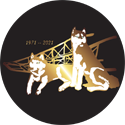


Siberians are natural athletes. They have been bred for speed and endurance. These qualities along with their moderately sized agile body type, make them a natural for the sport of agility. Dog agility involves the dog going over or through multiple obstacles including: A-frames, jumps of various sizes and styles, closed tunnels, open tunnels, dog walks and weave poles. From the dog's point of view, this is a fantastic doggy playground.
Participating in the sport of agility requires some planning on the owner's part. As with any sport there are rules, most of which are here to insure that the dog can participate safely. Before starting in agility the owner needs to take the time to do basic obedience training. Most dogs (of any breed) that fail the course in competition do so because they are not under control. A second thing to consider is your dog's overall physical condition. This is an athletic endeavor that requires the dog to be in good physical condition -- not overweight or under exercised.
Siberians do have some breed characteristics that can work against you if not taken into consideration at the beginning of your training. The comment I hear most often when someone hears I do agility with my Siberian Husky is, "Don't you have to take the leash off to do that?" With the Siberian's reputation for running, it's not surprising that this question comes up. Many people avoid any activity that requires their Siberian to be off leash. This comes back to the need for basic obedience before starting agility. You must have off leash control of the dog to participate in agility trials. Whether you plan to do obedience, agility or just have a living pet, this is an issue that must be addressed for your dog's safety. I start teaching my dog the "come" command the minute it comes through my door. "Come" is not something I leave to chance. Even with extensive training, no dog will come 100% of the time -- even if it is a Golden Retriever, Sheltie, etc. I think we sell our dogs short when we avoid teaching them any command or activity because we already decided they can't do it.
While it is not the intention of this article to teach you how to have a reliable "come" command, let me give you a few things to think about as you work towards this goal with your dog. A dog that has a history of good experiences when coming to you is less likely to ignore your call to come. I spend a lot of time, from the time my dog first comes to my house, building a long history of reward for coming to me. I never punish my dog when it comes to me, even if it just did something bad. Coming to me is always a good thing. Also, because I do a lot of training with my dogs, using a lot of positive reinforcement (praise, food, etc.) my dogs think being with me or coming to me means good things are about to happen. One last thought, do you prefer being with someone that yells at you all the time, telling you that you never do anything right or someone that tells you how great you are and what a wonderful, intelligent person you are. Guess what, your dog feels the same way.
Remember that agility requires physical conditioning. Before taking your couch potato for a ten mile run, take him to the vet for a physical. Be sure that your dog's weight is appropriate for his size and body type. If your dog is a little overweight, deal with that. Olympic athletes don't compete unless they are in shape. Start you dog's exercise program gradually keeping his current physical condition in mind. Start with walks suitable in length to your dogs ability and gradually build on that foundation.
Once your dog is in condition and you have basic control (meaning your dog will come when called) you are ready to start teaching the dog how to negotiate the obstacles. It is best to find a class in your area with an experienced instructor. Be sure to observe the class before signing up. A class situation will help you avoid pitfalls in training and to safely introduce each obstacle. Initial introduction to obstacles needs to be done in a controlled fashion for safety. Safety for your dog should always be your first consideration.
Before you start any training session or before competing at a trial you need to warm your dog up. Think about those Olympic athletes. They just don't go out with cold muscles and do the high jump. That would cause pulled or torn muscles. Run your dog back and forth to war up those muscles. Once the dog is warmed up a little, do some stretches with him. Some good information on this can be found in the book, Peak Performance, Coaching for the Canine Athlete by Christine Zink.
Agility is a fun activity for both the dog and its owner. There are many
Siberians competing successfully at all levels of competition. If you're looking
for something fun that makes use of your dog's natural abilities agility might
be the sport for you.
take me back up
Copyright © 1998-2021,
Northern California
Siberian Husky Club, Inc.
All rights reserved.
This page last updated: 01/03/2021